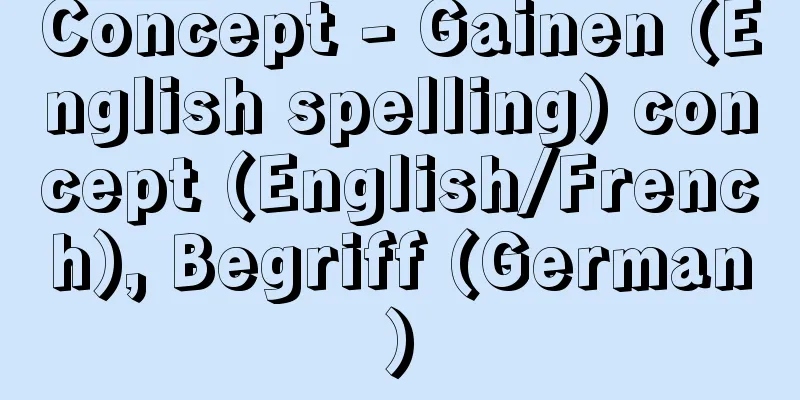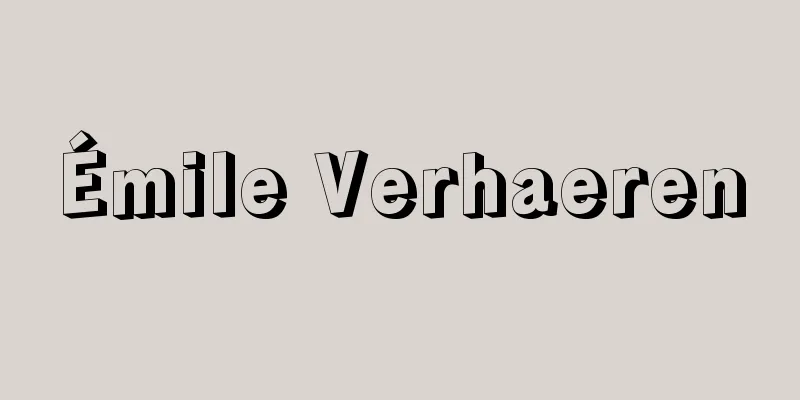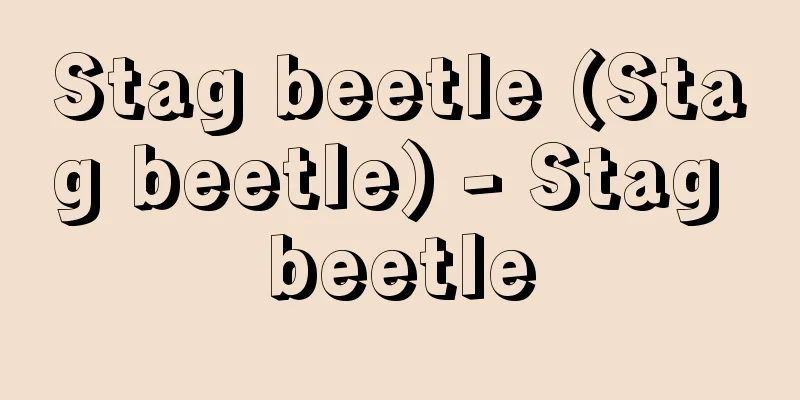Concept - Gainen (English spelling) concept (English/French), Begriff (German)

|
A class of things that are distinguished by their essential characteristics, or a mode of thinking that categorizes them. The essential characteristics and their connections are called the connotation or intention of a concept, and the set of things that share the same connotation is called the denotation of a concept. For example, "boy" has the connotation of "young" (roughly 5-6 years old to 11-12 years old) and "male," and its denotation forms a boundary that separates it from adjacent concepts such as "young man." Concepts are a basic function of classical logic along with judgment and inference, and thinking is said to proceed along this three-dimensional hierarchy, so they have also become a basic concept in thinking psychology (Tatsuro Yatabe, Thinking Psychology 1: Concepts and Meanings, 2: Relations and Inference, 1948-49). The function of abstracting, classifying, and ordering diverse experiences according to some criteria is called conception. Conceptual function has the roles of classification, understanding, prediction, inference, etc. (Eysenck, MW, 1990), and enables the formation of stable and orderly cognition. However, Yatabe pointed out that because concepts, judgments, and inferences mutually and circularly determine each other, the definition of concepts in classical logic does not necessarily fit the diverse ways of thinking in reality. In psychology, there is also the view that concepts are merely compressed representations of past experiences. Wittgennstein, L. (1953) also showed that it is difficult to define everyday concepts such as a game or a chair by their essential attributes. In response to this situation, the more flexible term "category" has gradually come to be used more frequently than the rigid term "concept." [Concepts and categories] Concepts and their representations remain one of the ultimate problems in cognitive science, but concepts are generally considered in relation to categories. A category can be defined as "a collection of similar objects or events" or "a collection of objects or events for some purpose or utility." Cognitive science also takes a broader view of "concept" and often uses it almost synonymously with "knowledge." For example, "an infant's concept of living things" has the same meaning as "an infant's knowledge about living things," and is even broader than a category. [The role of categories] Why do we create categories? First, an important role of categories is to reduce the burden on memory by grouping different examples together as "the same thing." If we were to recognize Pochi at home, Taro at the neighbor's house, and the many dogs we encounter on the street as separate individuals, distinguishing them from one another, and to remember all of their minute characteristics, the burden would be enormous. Another role of categories is to serve as a basis for inferences about the properties of objects that we have never seen or have little knowledge about. It is too inefficient to learn the attributes of each object one by one in order to learn the properties of the object. When people learn that an object actually has an attribute, they inductively generalize it and infer that other objects also have that attribute, thereby building a concept. However, when making inductive inferences, it is important to consider to what extent we generalize knowledge about a specific case. We use the same category as the basis for inductive inferences, and we think that objects that belong to the same category share some meaningful attribute. As a result, even if we do not know whether an object has attribute X, if we learn that another object in the same category has X, we can infer that the object in question has X. However, naturally, this raises the question of what kind of category is the basis for inductive inference of attributes. This is an important question in itself, but to do so, we must consider the question of what kind of categories exist in the mind. Taxonomic categories The most well-known useful category is the taxonomic category. Things that exist in the world can be classified into an ontological tree, a hierarchical tree structure based on the grouping of concepts. The ontological tree branches into concrete and abstract concepts, and below concrete concepts, it branches into natural and artificial objects, and below natural objects, it branches into living things and non-living things, and then into animals and plants. The most commonly used and useful category in the hierarchical structure is the basic level, and for example, "dog," "cat," "apple," and "chair" are basic level categories. At this level, the similarity between members (things and events) in the category is at its highest and the similarity between adjacent category members is sufficiently low that Rosch, E., said that this is the category "in which the world naturally divides itself." Basic level categories are also the most universal across cultures and languages, and are the categories whose labels children learn the earliest. At the superordinate level, the perceptual features of category members become more diverse, making it difficult to infer membership based on perceptual similarity. Conversely, at the subordinate level (such as types of apples or types of cats), it becomes difficult to discriminate between members of adjacent categories based on their similarity. Taxonomic categories are thought to be hierarchically organized such that at each node, where each branch branches off, distinct attributes are shared between the categories they contrast with, and categories at lower levels in the tree structure are thought to inherit the attributes of the nodes above them. Due to the above structure, members of the same category are thought to share important attributes that distinguish them from other contrasting category members. Therefore, taxonomic categories, especially basic-level categories, are considered to be the categories that best support inductive inference of attributes. Taxonomic categories also have conventional labels in every language. For this reason, children rely on the labels to believe that things that share the same label share important attributes. It is believed that this assumption allows children to rapidly learn the attributes of objects and build concepts without having to learn the attributes of each object one by one. However, as will be described later, in order to learn attributes by inductive inference, it is necessary to have a certain amount of prior knowledge and to be constrained by it in order to make meaningful inferences. For example, questions such as whether a feature seen in a specific example (e.g., a rabbit) (e.g., one ear is folded) is a feature that can be generalized to other category members, or whether the attribute that a certain type of rabbit is fertile is generalized only to that type of rabbit or to rabbits in general, or whether it can also be generalized to hamsters that look like rabbits, cannot be determined without a certain amount of knowledge. To solve this problem, we must devise a model in which concepts are developed by using labels as clues while simultaneously activating a variety of processing processes through interaction with prior knowledge. [Associative categories and goal directed categories] When we think of categories, we tend to think only of taxonomic categories, but people also create categories based on associative relationships (thematic categories) and categories based on use or purpose (goal directed categories). In the field of conceptual development, these categories have been treated as immature categories unique to children, and it has been thought that the normative categories for adults are taxonomic categories. The transition from associative categories to taxonomic categories was thought to represent conceptual development. However, adults also create categories based on use or purpose on a daily basis. Examples include disaster supplies, golf equipment, and pet supplies. The items included in these categories are grouped together not because they have common attributes, but only because of their purpose or theme, such as items needed in the event of a disaster or items needed for pet care. However, these categories are extremely important for people (adults) to organize the everyday world that surrounds them. When we think about it this way, the boundary between categories based on associative relations/purpose and taxonomic categories is not so clear. For example, "furniture," "pets," and "food" have been treated as taxonomic categories in conceptual and conceptual development research, but their nature is much closer to that of purpose-based categories. Therefore, the view that only taxonomic categories are normative categories for adults should be reconsidered, as people organize and classify the world in multiple ways depending on the purpose and use them flexibly. It is better to think that what is important for conceptual development is not only to acquire taxonomic categories, but also to learn how adults organize the multiple worlds in the culture surrounding oneself according to the purpose, and to learn to flexibly create categories based on multiple criteria according to the situation and purpose, just like adults. [Theories of the Meaning of Concepts] In the 1960s and 1970s, the idea that concepts are represented in the mind as feature lists composed of semantic features that cannot be divided any further, and that true or false is determined uniquely in a given world, was based on the truth value of logic. This feature list theory was considered the standard theory of the meaning of concepts, due to its concise expression and ease of description in computers. However, various problems soon emerged when dealing with human concepts, as described below. The current theories and models of concepts were proposed to overcome the problems of feature list semantics, and there have been two research trends here. One trend is typicality theory, and the case-based theory and explanation-based theory, which were proposed to overcome that problem. The other trend is the relationship between concepts and embodiment. The basis of feature list theory is the idea that concepts and the meaning of words are abstract representations that are separate from the body. In recent years, some conceptual researchers have overturned this fundamental idea and are moving in the direction of clarifying how the body is involved in people's conceptual representations. Feature list theory is also called classical semantic theory, and is also called checklist semantics by CJ Fillmore, who criticized this theory. This theory is based on the semantics of logic and holds that concepts are represented in the mind as a list of features that are necessary and sufficient to determine their extension (category membership). In a given world, this list (intension) can determine the truth value of the extension (i.e., whether or not each instance in the world is included in the extension of the concept) without exception. But once we think concretely about everyday categories, we cannot find a feature list that can unambiguously define the denotation of most things. For example, the feature that distinguishes a tiger from other big cats is its black stripes, but albino tigers without these stripes are also tigers, and so cannot be included in a necessary and sufficient feature list. However, we cannot distinguish a tiger from a lion, a leopard, etc., based only on the attributes common to all instances of tiger (not to mention the question of what those attributes are, and whether they are really conceptual features that can be further decomposed). The second problem is that there are only a very small number of concepts whose category membership is unambiguously determined. For example, there is no agreement even among speakers of the same language as to whether a floor lamp or a carpet is "furniture" or not. The third problem is that feature list theory does not take into account the structure of concepts at all. In other words, the truth or falsity of an example is determined univocally by the feature list, and it does not take into account that among the examples in the extensional category, there are examples that are clearly felt to be good (suitable as examples) and examples that can be considered category members but are not felt to be very good examples. Good examples of a category are called prototypes, and many categories have a gradient structure with a central tendency, in which the "goodness" of a category member fades as you move from the prototype to the periphery. For example, in the category of "birds," many people think that canaries, sparrows, and swallows are very bird-like, that is, typical birds, but while they acknowledge that chickens, penguins, and ostriches are birds, they do not think that they are typical birds. When asked to judge the truth of the sentences "Swallows are birds" and "Penguins are birds," the former can be judged faster than the latter. This phenomenon cannot be explained by the feature list model. [Prototype theory and case-based theory] Proposed by Rosch as a conceptual model that can avoid the problems of the feature-list model described above, prototype theory has been widely accepted since the late 1970s. In this theory, as described above, concepts are considered to be mental representations with a continuous structure centered on a prototype. Whether or not an individual example is included as a member of the concept is determined by its similarity to the prototype. The category member that is the referent of a word does not need to have all the features of the prototype; one that has more features is a better referent of the word, and one that has less overlapping features with the prototype is ambiguous as to whether it is included as a category member. Furthermore, the features themselves do not necessarily need to be elementary (indivisible) of the concept, as in the feature-list model described above (so a tiger's stripes would be a perfect feature in typicality theory). A problem with typicality theory is how to determine a "typical example." It cannot be explained by the frequency or familiarity of encountering a particular example. For example, in the case of "birds," most people are unfamiliar with wild birds such as the varied tit (a wild bird related to the Japanese tit) that live in rural areas and do not come to urban areas, whereas chickens are very familiar to us in our daily lives. Despite this, people think that chickens are atypical birds and that varied tits are typical birds. Roche argued that typicality is determined not by the frequency of a particular example itself, but by how many characteristics the example shares with other members of the category as family resemblance, and how little similarity it has with members of other categories. The varied tit is judged to be "highly typical" because it shares many characteristics with canaries, sparrows, and swallows, but chickens are judged to be atypical because they do not share many characteristics with the members of the central "bird" category. In this way, typicality theory considers that concepts are represented as a weighted set of features that average the characteristics of members close to the center of the category. In this case, the prototype does not necessarily match a specific example. In the case of the "bird" category, this idea works to some extent. However, in the case of the "furniture" category, where the members considered to be prototypes (desks, chairs, beds, etc.) are diverse in both perceptual and functional terms, it becomes difficult to imagine the prototype as an averaged set of features, and it is possible that a specific example is the prototype. Because it is difficult to turn an averaged set of features into a prototype, the exemplar-based theory was proposed. In this theory, people represent individual examples of category members, and category members are judged by their similarity to individual members, not by their abstract features. However, whether typicality theory or example-based theory is used, the essential problem remains as to whether the similarity is determined by a standard, and further, how abstract the prototype or individual examples are represented in the first place. [Explanation-based theory] As mentioned above, the key to both typicality theory and case-based theory is how people determine similarity with prototypes or cases. Various models for calculating similarity have been proposed within the framework of typicality theory and case-based theory, but these mainly calculate similarity based on perception or pre-determined features. In other words, the similarity that determines category membership exists independently of context, and it was assumed that similarity can be determined by mechanical algorithms. However, here, the question of whether context-independent similarity exists itself becomes an issue. This is because people consider various relationships to be "similar" using various standards, and similarity is greatly influenced by context. For example, the similarity between the UK and the US is judged to be low in the set of the UK, the US, France, and Germany, but is much higher in the set of the UK, the US, Australia, and South Africa. There are cases where similarity does not necessarily contribute to the determination of category membership. For example, when a person is shown an unknown round object with a diameter of 3 cm and asked whether it resembles a 500 yen coin or a pizza, he or she will judge it to be more similar to the 500 yen coin, but when asked whether the object is a 500 yen coin or a pizza, he or she will answer that it is a pizza. This is because people know that a 3 cm pizza is not typical, but it is not impossible to make it that size, and that a 500 yen coin is 2.65 cm in size, with no deviation of even 1 mm. This phenomenon is difficult to explain with models in typicality theory and case-based theory, which calculate similarity based on the degree of shared attributes. In other words, people use existing knowledge to determine category membership using different similarities depending on the context, and explanation-based theory takes the view that knowledge plays a major role in category formation and category membership. Explanation-based theory does not deny the fact that people have propositional feature lists as semantic representations of concepts, as in feature list theory and typicality theory. However, the feature lists in those theories do not take into account the relationships between features, and it is assumed that features exist independently. In explanation-based theories, it is assumed that characteristics are organically and causally related to each other through an explanatory framework, which also differs from previous theories. As mentioned above, typicality theory, case-based theory, and explanation-based theory have been proposed to overcome the shortcomings of the feature list model, but it is difficult to decide which of these theories is the best. Although it is natural that existing knowledge is used when determining category membership, it is very difficult to create some kind of mathematical model within the framework of this theory, and it ultimately comes down to the question of what knowledge people have and in what situations they use it. In addition, both infants and adults form categories based on perceptual similarity even with almost no prior knowledge. In this case, learning must be case-based at the beginning, but as the number of cases increases, the core of the category is formed and a prototype is formed. However, individual cases do not disappear from memory, and category membership may be determined by similarity to one case. In the end, it is better to think of these theories as mutually complementary, rather than exclusive. [Embodiedness of concepts] When trying to express concepts using feature lists, as in feature-based theory, the conceptual representation is assumed to be propositional and abstract, separate from bodily sensations. In contrast, the idea that conceptual representations are images, which are closely associated with bodily sensations, and that the brain performs bodily simulations when recalling a concept has been proposed. This was taken up and attracted attention as the proposition-image debate, but in recent years it has come to be seen as a problem of embodied cognition. Many results have been reported in recent brain functional imaging studies that support this idea. For example, simply recalling the name of a color has been confirmed to activate area V4, which processes colors, and reading words that describe actions performed with parts of the body, such as licking, kicking, and touching, has been shown to activate the sensorimotor areas that correspond to the meaning of the words as well as the areas that process the meaning. However, the fact that conceptual processing involves bodily simulation does not exclude the fact that the mind has propositional characteristics. Recent findings in neuroscience have shown that concepts are not concentrated in a certain part of the brain, but are represented in a distributed manner throughout the brain, and it is possible that information abstracted from individual experiences is represented in a certain part of the network. In any case, however, it is not clear whether information representation within the theoretical framework of embodied cognition is an image-based analog representation or whether it is partially propositional, and the very definition of an image remains a major problem. [Concepts and word meanings] In conventional conceptual research, words have been treated as conceptual units. It has been thought that people have the concept of "chair" that corresponds to the word "chair". However, if words are conceptual units, a big problem arises. As the linguistic relativity hypothesis asserts, the way in which words divide the world varies greatly depending on the language. Various studies on the linguistic relativity hypothesis suggest that our concepts are influenced by language. On the other hand, it has been shown that there are universal commonalities even if the division of concepts by language varies greatly depending on the language. For example, Dutch does not have a word corresponding to the Japanese word "walk," but uses four words to describe the action corresponding to "walk" depending on the speed and manner. However, when the speed was systematically increased from a slow walking speed on a treadmill and the names of the actions at each speed were heard, English speakers, Spanish speakers, and Dutch speakers all switched the names of the actions at the exact same point where the Japanese speakers switched from "walk" to "run." In other words, the segmentation of biological motion of humans, such as "walk" and "run," exists universally in languages. This is also suggested by the fact that infants before they learn language can discriminate various biological motions. This raises the question of whether humans can have universal concepts independent of language and culture, as well as the question of whether the unit of a concept should really be a word. Even though the division of perception or conceptual domains by words differs depending on the language, if there is a universal commonality across languages, a recent view has emerged that we should reconsider the premise that the unit of a concept to be described is a word, the meaning of which often differs greatly depending on the language. →Semantics →Concept learning →Linguistic relativity hypothesis →Mental image →Knowledge [Mutsumi Imai] Latest Sources Psychology Encyclopedia Latest Psychology Encyclopedia About Information |
|
本質的特徴により区別された事物の類,また類別する思考様式。本質的特徴とその連関を概念の内包connotation,intension,内包を共有する事物の集合を概念の外延denotationとよぶ。たとえば「少年」は,「年少」(おおむね5~6歳から11~12歳),「男性」という内包をもち,その外延は隣接する概念,「青年」などとを区切る境界をなす。概念は判断・推理と並ぶ古典論理学の基本機能であり,思考作用はこの階層をなす三次元に沿って進行するとされたため,思考心理学でも基本概念となった(矢田部達郎『思考心理学1概念と意味,2関係と推理』1948~49)。多様な経験をなんらかの基準により抽象化して類別し整序する機能を概念作用conceptionとよぶ。概念作用は分類,理解,予測,推論などの役割をもち(Eysenck,M.W.,1990),安定し秩序だった認知形成を可能にする。しかし,矢田部は,概念・判断・推理は相互循環的に規定し合うことから,古典論理学的な概念の定義は現実の多様な思考様式には必ずしも適合しないことを指摘した。心理学的には概念は過去経験の圧縮された表象に過ぎないとする見解もある。また,ウィトゲンシュタインWittgennstein,L.(1953)は,ゲームや椅子のような日常的概念も本質的属性によって定義するのは困難であることを示した。このような情勢を受けて,概念という硬い用語に対しより柔軟な「カテゴリー」がしだいに多用されるに至っている。 【概念とカテゴリー】 概念とその表象は,依然として認知科学における究極の問題の一つといってよいが,一般的には概念はカテゴリーとの関係で考えられている。カテゴリーcategoryは「類似したモノや事象の集まり」あるいは「なんらかの目的,有用性のためのモノや事象の集まり」と定義することができる。また,認知科学では「概念」をより広義にとらえ,「知識knowledge」とほぼ同義に使う場合も多い。例えば「幼児の生物概念」は「幼児のもつ生物についての知識」と同じ意味であり,カテゴリーよりもさらに広い。 【カテゴリーの役割】 われわれは何のためにカテゴリーを作るのだろうか。まず,異なる事例を「同じもの」としてまとめることで記憶の負荷を軽減するというのは,カテゴリーの重要な役割である。自分の家のポチ,隣の家のタロー,道で遭遇する多くのイヌたちを「イヌ」として認識せず,すべて別々の個体として互いを区別して認識し,そのために細かい特徴をすべて記憶しなければならないとしたらその負荷は膨大なものになる。 カテゴリーのもう一つの役割は,カテゴリーが,実際には見たことがない,あるいはあまり知識がないモノの性質についての推論のベースとなることである。モノの性質を知るためにモノ一つひとつについて逐一属性を学習するのは効率が悪すぎる。人は実際にはあるモノに○○という属性があることを知ると,それを帰納的に一般化して他のモノもその属性をもつと推論し,そのことによって概念を構築していく。ただし,帰納的推論をする場合,特定の事例についての知識をどの範囲で一般化するかが重要である。わたしたちは同じカテゴリーを帰納的推論の基盤に用い,同じカテゴリーに属するモノはなんらかの意味ある属性を共有すると考える。それによって,あるモノがXという属性をもっているかどうか知らなくても,それと同じカテゴリーに属する別のモノがXをもっていることを学習すれば,当該のモノがXをもつことを推論する。ただし,当然のことながら,ここで,属性の帰納的推論の基盤になるカテゴリーとはどのようなカテゴリーなのかという問題が生ずる。これ自体が重要な問題であるが,そのためには,どのような種類のカテゴリーが心に存在するのか,という問題を考えなければならない。 【分類学的カテゴリーtaxonomic category】 有用性をもつカテゴリーとして最もよく知られているのは分類学的カテゴリーである。世界に存在するモノは存在論樹木ontological treeとよばれる,概念のまとまりによって階層性をもつ樹木構造に分類できる。存在論樹木は具象概念と抽象概念に分岐し,具象概念の下位で自然物と人工物に分岐し,自然物の下位でさらに生き物とそれ以外,生き物がさらに動物と植物に分岐する。階層構造の中で最もよく使われ,有用性が高いのは基礎レベルbasic levelとよばれるカテゴリーで,たとえば「イヌ」「ネコ」「リンゴ」「イス」などは基礎レベルである。このレベルは,カテゴリーにおける成員(モノや事象)間の類似性が最大になり,隣接するカテゴリー成員との類似性が十分に低くなるので,ロッシュRosch,E.は「世界が自然に自らを分割している」カテゴリーであると言った。基礎レベルカテゴリーはまた,文化・言語をまたいで最も普遍性が高く,子どもが最も早くにそのラベルを覚えるカテゴリーである。上位レベルsuperordinate levelになるとカテゴリー成員の知覚的特徴が多岐にわたるようになり,知覚的類似性で成員を推測することは難しくなる。反対に下位レベルsubordinate level(リンゴの種類,ネコの種類など)は隣接するカテゴリーの成員の類似性に対しての弁別が難しくなる。 分類学的カテゴリーは階層的にそれぞれの枝が分岐するノード(節)nodeにおいて,そのノードで対比されるカテゴリーと区別される属性が共有されると考えられ,樹木構造の下のレベルのカテゴリーはそのノードより上にあるノードの属性を受け継ぐと考えられている。 上記の構造のため,同じカテゴリーの成員は,ほかの対比するカテゴリー成員と当該カテゴリー成員とを区別するうえで重要な属性を共有すると考えられる。よって,分類学的カテゴリー,とくに基礎レベルカテゴリーは属性の帰納的推論を最もよく支えるカテゴリーであるとされている。また,分類学的カテゴリーはどの言語でも慣習的なラベルをもっている。このため,子どもはラベルを頼りに,同じラベルを共有するモノ同士は重要な属性を共有すると考える。この思い込みによってモノ一つひとつについてその属性を逐一学習しなくても急速にモノの属性を学習し,概念を構築していくことができると考えられている。ただし,後に述べるように属性を帰納的推論によって学習するためにはある程度の先行知識をもち,それに制約されなければ意味ある推論はできないはずである。たとえばある特定の事例(たとえばウサギ)に見られる特徴(たとえば片方の耳が折れている)がほかのカテゴリー成員に一般化できる特徴なのか,あるいは,ある種類のウサギが多産であるという属性を一般化するのはその種類のウサギに限るのかウサギ一般なのか,あるいは見た目がウサギに似たハムスターなどにも一般化されるのか,という問題はある程度の知識がないと決定できない。このような問題を解決するには,ラベルを手がかりとしながらも先行知識との相互作用によって多様な処理過程を同時に発動しながら概念を発達させていくようなモデルを考えなければならない。 【連想カテゴリーと目的カテゴリー】 カテゴリーというと分類学的カテゴリーのみを考えがちであるが,人は連想関係に基づくカテゴリー(連想カテゴリーthematic category)や,用途・目的に基づいたカテゴリー(目的カテゴリーgoal directed category)も作る。概念発達の分野ではこれらのカテゴリーは子どもに特有の未成熟なカテゴリーとして扱われ,成人にとって規範的なカテゴリーは分類学的カテゴリーであると考えられてきた。連想カテゴリーから分類学的カテゴリーへの移行が概念の発達であると考えられたのである。しかし成人でも日常的に用途・目的に基づいたカテゴリーを作る。たとえば災害用品,ゴルフ用品,ペット用品などはその例で,これらのカテゴリーに含まれるモノは共通した属性をもつことによってではなく,災害時に必要なモノ,ペットのケアのために必要なモノという目的やテーマ性のみでまとめられているが,人(成人)が自分を取り巻く日常世界を整理するためには非常に重要なカテゴリーである。 このように考えると連想関係・目的に基づいたカテゴリーと分類学的カテゴリーはそれほどはっきり境界をもつわけでない。たとえば「家具」「ペット」「食品」は概念研究や概念発達研究において分類学的カテゴリーとして扱われてきたが,その性質は目的に基づいたカテゴリーにずっと近い。したがって,これまでの分類学的カテゴリーのみが成人にとっての規範的カテゴリーであるという見方は考え直されるべきで,人は用途に応じて複数の仕方で世界を整理し,分類していてそれを柔軟に使い分けているのである。概念発達にとって大事なのも,分類学的カテゴリーを習得することのみではなく,用途に応じて自分を取り巻く文化の中でおとながしている複数の世界の整理の仕方を学び,おとなのように状況や目的に応じて柔軟に複数の基準でカテゴリーを作っていくことを学ぶことであると考えた方がよい。 【概念の意味の諸理論】 1960~70年代には,概念とは,これ以上分割できない意味素性で構成される特徴リストとして心の中に表現され,与えられた世界において一義的に真偽が決まる,という論理学の真理値に依拠した考え方が支配的であった。この特徴リスト理論は,表現が簡潔であり,計算機における記述がしやすいことも相まって,概念の意味の標準理論と考えられたが,人の概念を扱うには,後述のようなさまざまな問題がすぐに浮上した。概念をめぐる現在の諸理論,諸モデルは特徴リスト意味論の問題点を克服すべく提案されたものであるが,ここにおいて二つの研究の流れがあった。一つの流れは典型性理論,さらにその問題を克服するために提案された事例ベース理論と説明ベース理論である。もう一つの流れは概念と身体性の関係である。特徴リスト理論の根底には,概念や語の意味は,身体と切り離された抽象的な表象であるという考えがある。近年の概念研究者の一部はこの根本的な考え方を覆し,人の概念表象に身体がどのようにかかわっているかを明らかにする方向に向かっている。 【特徴リスト理論feature list theory】 特徴リスト理論は古典的意味理論ともよばれ,また,この理論を批判したフィルモアFillmore,C.J.の用語ではチェックリスト意味論ともよばれる。この理論は,論理学の意味論に依拠しており,概念は外延(カテゴリー成員)を決定するために必要にして十分な意味素性で構成される特徴リストとして心の中に表現されると考える。所与の世界では,このリスト(内包)によって,外延の真理値(つまりその世界における個々の事例が概念の外延に含まれるか否か)は例外なく決定できるとする。 しかしひとたび日常的なカテゴリーについて具体的に考えると,ほとんどのモノについて外延を一義的に定義できるような素性リストを見つけ出すことができない。たとえば「トラ」をほかの大型ネコ科動物と区別する特徴は黒の縞模様だが,この縞模様のないアルビノのトラも「トラ」であるので,必要十分な素性リストには入れられない。しかし,「トラ」のすべての事例に共通する属性のみでは(その属性が何なのか,ほんとうにそれらがそれ以上分解可能な概念素性なのか自体も問題であるが),「トラ」と「ライオン」や「ヒョウ」などと区別ができなくなってしまう。第2の問題は,カテゴリー成員が曖昧性なく決まる概念も全体から見ればごく一部しか存在しないということである。たとえばフロアランプや絨毯は「家具」なのかそうでないのかは,同じ言語の話者の間でも一致を見ない。第3の問題は,特徴リスト理論では,概念の構造をまったく考えないことである。つまり,特徴リストによって事例の真偽が一義的に決まるので,外延カテゴリーに含まれる事例の中で明らかに良い(事例としてふさわしい)と感じられる事例,カテゴリー成員とはみなせるがあまり良い事例だと感じられない事例があることは考慮しない。カテゴリーの良い事例は典型prototype(プロトタイプ)とよばれ,プロトタイプを中心に周辺に向かうにつれてカテゴリー成員としての「良さ」が薄れていく,中心傾向central tendencyをもった連続的構造gradient structureを多くのカテゴリーがもっている。たとえば,「鳥」というカテゴリーにおいて,多くの人はカナリアやスズメ,ツバメは非常に鳥らしい鳥,つまり典型的な鳥であると思うが,ニワトリやペンギン,ダチョウは鳥であることを認めても,典型的な鳥であるとは思わない。「ツバメは鳥である」という文と「ペンギンは鳥である」という文の是非を判断するように求められると,前者の方が後者よりも速く判断できる。このような現象を特徴リストモデルでは説明できない。 【典型性理論と事例ベース理論】 前述の特徴リストモデルの問題を回避できる概念モデルとしてロッシュによって提唱され,1970年代後半から広く受け入れられてきたのが,典型性理論prototype theory(プロトタイプ理論)である。この理論では,前述のように,概念はプロトタイプを中心にした連続的構造をもつ心的表象と考える。個々の事例がその概念の成員に含まれるかどうかはプロトタイプからの類似度で決まる,と考える。語の指示対象となるカテゴリー成員は,プロトタイプのもつ特徴をすべてもつ必要はなく,より多くもつものがその語の指示対象としてより良いものとなり,プロトタイプとの特徴の重複が少ないものはカテゴリー成員に含まれるかどうかは曖昧になる。また,特徴自体も,必ずしも前述の特徴リストモデルのように,概念の原素的な(これ以上分けられない)ものである必要はない(したがって,トラの縞模様は典型性理論では立派に特徴になる)。 典型性理論で問題になるのが,「典型的な事例」はどのように決まるのかということである。特定の事例にどれだけ遭遇するかという頻度やなじみ度では説明できない。たとえば「鳥」の場合,ヤマガラ(シジュウカラの仲間の野鳥)のように里に生息し,都市部に来ない野鳥はほとんどの人にとってなじみが薄いのに対し,ニワトリは日常的に非常になじみ深い。それにもかかわらず,人はニワトリは非典型的な鳥だと思い,ヤマガラは典型的な鳥だと思う。ロッシュは,特定の事例自体の頻度ではなく,その事例がカテゴリーのほかの成員とどのくらい家族類似性family resemblanceとしてたくさんの特徴を共有し,かつ,ほかのカテゴリーの成員とどれだけ類似性が低いか,ということで典型性が決まると主張した。「ヤマガラ」はカナリア,スズメ,ツバメと共有する特徴を多くもっているので「典型性が高い」と判断されるが,ニワトリは「鳥」カテゴリーの中心部にいる成員たちと特徴の共有が多くないため非典型的であると判断されるのである。このように,典型性理論では概念はカテゴリーの中心に近い成員の特徴を平均化した重み付けをされた特徴集合として表象されていると考えられている。この場合,プロトタイプは必ずしも具体的な事例とは一致しない。「鳥」カテゴリーの場合はこの考えである程度うまくいく。しかし「家具」カテゴリーのように,プロトタイプとされる成員(机,イス,ベッドなど)が知覚的にも機能的にも多岐に及ぶ場合,平均化された特徴集合としてプロトタイプを想定するのは難しくなり,特定の事例がプロトタイプとなっている可能性も考えられる。平均化された特徴集合をプロトタイプにすることが困難なことから,事例ベース理論exemplar based theoryが提唱された。この理論では,人はカテゴリー成員の個々の事例を表象しており,抽象化された特徴ではなく個々の成員との類似性でカテゴリー成員が判断されるとする。しかし,典型性理論にしろ,事例ベース理論にしろ,基準で類似性を決めているのかということ,さらに,そもそもプロトタイプあるいは個々の事例のどのくらいの抽象度で表象されているのかということが本質的な問題として残る。 【説明ベース理論theory based theory】 前述のように典型性理論,事例ベース理論はともに人がどのようにしてプロトタイプなり事例なりとの類似性を決めるのかが鍵になる。典型性理論,事例ベース理論の枠組みで類似性を計算するさまざまなモデルが提唱されたが,これらは主に知覚ベース,あるいは事前に決められた特徴ベースで類似性を計算するものであった。いわば,カテゴリー成員を決定する類似性は文脈とは独立に存在し,機械的なアルゴリズムで類似性が決定できる前提で考えられていた。しかしここで,文脈独立の類似性が存在するかということ自体が問題になる。人はいろいろな基準でいろいろな関係を「類似」とみなし,類似性は文脈に大きく影響されるからである。たとえばイギリス,アメリカ,フランス,ドイツという集合の中でのイギリスとアメリカの類似性は低いと判断されるが,集合がイギリス,アメリカ,オーストラリア,サウスアフリカという集合の中では,前者の場合よりずっと高くなる。類似性が必ずしもカテゴリー成員の決定に寄与しない場合もある。たとえば直径が3㎝の未知の丸い物体を見せられ,これが500円硬貨とピザのどちらに似ているかと聞かれたときには人は500円硬貨により似ていると判断するが,その物体が500円硬貨なのかピザなのかと聞かれると,ピザであろうと答える。3㎝のピザは典型的ではないにしろその大きさで作ることは不可能ではなく,500円硬貨の大きさは2.65㎝で,1㎜の逸脱もないことを人は知っているからである。このような現象は,属性の共有の度合いで類似性を計算する典型性理論や事例ベース理論におけるモデルでは説明が困難になる。つまり,人は既存の知識を用いて文脈に応じて異なる類似性を用いてカテゴリー成員を決めているのであり,知識がカテゴリー形成やカテゴリー成員に大きな役割を果たすという見方が説明ベース理論である。説明ベース理論は特徴リスト理論,典型性理論のように人が概念の意味表象として命題的な特徴リストをもつこと自体を否定するものではない。ただし,それらの理論での特徴リストは特徴同士の関係性が考慮されておらず,特徴が独立に存在するという前提であった。説明ベース理論では,説明枠組みによって特徴同士が有機的・因果的に関係づけられていると考える。この点もそれ以前の理論と異なる。 以上,特徴リストモデルの欠点を克服すべく典型性理論,事例ベース理論,説明ベース理論が提唱されてきたが,これらの理論のどれが最も優れているかを決めることは困難である。既存の知識がカテゴリー成員決定の際に用いられるのは自然なことであるが,この理論の枠組みでなんらかの数理モデルを作ることは非常に困難であり,結局人はどのような知識をもち,どのような状況で使うか,という問題に帰着してしまう。また,乳幼児も成人も事前知識がほとんどなくても知覚類似性をベースにしてカテゴリーを形成する。この場合,学習の当初は事例ベースにならざるをえないが,事例が増えるに従ってカテゴリーの中心が形成され,プロトタイプが形成される。ただし,個々の事例が記憶から消失するわけではなく,一つの事例との類似性でカテゴリー成員が決まる場合もある。結局これらの理論は排他的なものではなく,相互補完的なものであると考えた方がよい。 【概念の身体性】 特徴ベース理論のように特徴リストで概念を表現しようとする場合,想定する概念表象は身体感覚から分離した,命題的かつ抽象的なものになる。それに対して,概念表象はイメージで,密接に身体感覚を伴っており,ある概念を想起する際に脳は身体的なシミュレーションを行なっているという考え方が提案された。これは命題-イメージ論争として取り上げられ,注目されたが,近年は身体性認知enbodied cognitionの問題としてさらに脚光を浴びるようになった。近年の脳機能イメージング研究ではこの考えを支持する結果が多く報告されている。たとえば色の名前を想起するだけで色を処理するV4野の賦活が確認され,舐める,蹴る,触るなどの身体の部分で行なう動作の語を読むと意味処理を行なう領野と同時に語の意味に対応する感覚運動野の賦活が認められるという。しかし,概念処理に身体シミュレーションを伴うこと自体は,心が命題的な特徴をもっていることを排除するものではない。近年の脳科学の成果は,概念は脳のある部位にまとまって存在しているのではなく,脳全体に分散的に表現されていることを示しているが,ネットワークのある部分では個別の経験から抽象化された情報が表現されていることはあり得ることである。しかし,いずれにせよ,身体性認知の理論的枠組みの中での情報表現がイメージベースのアナログ的表象なのか,一部は命題的なものなのかということはわかっていないし,そもそもイメージとは何なのかということは未だに大きな問題として残されている。 【概念と語の意味】 従来の概念研究では単語が概念の単位として扱われてきた。人は「イス」という語に対応する「イス」という概念をもつ,と考えられてきたのである。しかし,ことばが概念の単位だとすると大きな問題が生じる。言語相対仮説の主張するように,ことばによる世界の切り分け方は言語によって大きく異なる。 言語相対仮説に関するさまざまな研究は,ことばによってわれわれの概念が影響されることを示唆している。一方,ことばによる概念の切り分けが言語によって大きく異なっても普遍的な共通性があることも示されている。たとえばオランダ語は日本語の「歩く」に対応する単語はもたず,「歩く」に対応するアクションをスピードと様態によって四つの語で言い分けている。しかし,ランニングマシンでゆっくり歩いているスピードからシステマティックにスピードを上げていき,それぞれのスピードでの動作の名前を聞いていくと,英語話者,スペイン語話者,オランダ語話者すべてが,日本語話者が「歩く」から「走る」に切り替えたまったく同じ所でそれぞれ動作の名前を切り替えていた。つまり,「歩く」と「走る」のような人のバイオロジカルモーションbiological motionの分節は言語に普遍的に存在するのである。これはことばを学習する以前の乳児がさまざまなバイオロジカルモーションを弁別することからも示唆される。 このことは,人が言語や文化と独立に普遍的な概念をもちうるのかという問題とともに,「概念」の単位をはたして「単語」としてよいのかという問題を浮上させる。言語に応じて知覚あるいは概念領域のことばによる切り分けが異なるのに,言語普遍的な共通性があるのなら,記述すべき「概念」の単位を,「言語によってその意味が大きく食い違うことの多い単語」としてきた前提自体を見直すべきだという考えも最近では出てきている。 →意味論 →概念学習 →言語相対仮説 →心的イメージ →知識 〔今井 むつみ〕 出典 最新 心理学事典最新 心理学事典について 情報 |
<<: Concept art - Gainen Geijutsu (English spelling) concept art
>>: Hoeryeong-dong Historic Site - Hoeryeong-dong Historic Site (English)
Recommend
Herbal medicine - shoyaku
Natural substances that occur in nature and that ...
Catalog sales - kataloguhanbai
...Customers select and order products by reading...
Play day - Asobibi
...In addition, in many cases, the amount of work...
Invalid
This was once a facility for wounded soldiers in P...
Assaka
…The term mahājanapada translates to “great count...
Gold - Kin
Au. Element with atomic number 79. Group 11 trans...
Ichiroku Iwaya
A Meiji politician and calligrapher. Born in Omi ...
Horsecutting - Umakiri
...Based on the book "Okubo Musashi Abumi,&q...
Neapolis (Soviet Union) (English spelling)
...It serves as a transportation hub for the Crim...
Demobilization - Demobilization
Used in contrast to mobilization, it refers to ret...
Kawachibushi - Kawachibushi
A perennial plant of the Ranunculaceae family (AP...
vajra
…means “something that is solid,” but usually ref...
Stock quality - Kabushichi
…The pawnbrokerage system, which corresponds to t...
Kijuro Shidehara
Politician and diplomat. Born in Osaka Prefecture...
Gaskol - Gaskol
... After that, the second oil shock at the end o...









